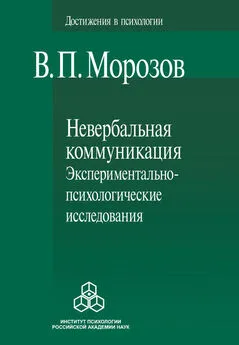Артемий Романов - Межпоколенческая коммуникация
- Название:Межпоколенческая коммуникация
- Автор:
- Жанр:
- Издательство:Книжный дом «ЛИБРОКОМ»
- Год:2009
- Город:Москва
- ISBN:нет данных
- Рейтинг:
- Избранное:Добавить в избранное
-
Отзывы:
-
Ваша оценка:
Артемий Романов - Межпоколенческая коммуникация краткое содержание
Впервые на русском языке приводится подробный анализ факторов, которые влияют на межпоколенческую коммуникацию внутри и вне семьи. Читатель познакомится с результатами проведенных автором социолингвистических опросов, проливающих свет на коммуникативное поведение россиян и их восприятие общения с людьми разного возраста. В работе приводятся многочисленные примеры общения между поколениями, как внутри семьи: между родителями и детьми, бабушками, дедушками и их внуками, тещами и зятьями, свекровями и невестка ми; так и вне семейного круга. Предлагаются практические рекомендации и советы, позволяющие решать задачи повышения уровня эффективности коммуникации между представителями разных поколений.
Книга адресована специалистам, интересующимся проблемами социолингвистики и речевой коммуникации, студентам, аспирантам и преподавателям вузов, социальным работникам и всем, чья профессиональная или общественная деятельность связана с коммуникацией между людьми разного возраста.
Межпоколенческая коммуникация - читать онлайн бесплатно полную версию (весь текст целиком)
Интервал:
Закладка:
Song, D., Youn, G Characteristics of loneliness for the elderly Korean. Journal of Korea Gerontological Society, 1989, 9, 64-78.
Street, R., Giles, H. Speech accommodation theory: a social cognitive approach to language and speech behavior. In M. E. Roloff and C. R. Bereger (Eds.), Social Cognition and Communication, Newbury Park, CA: Sage, 1982: 193-226.
Stuart, S., Vanderhoof, D., Beukelman, D. Topic and vocabulary use patterns of elderly women. Augmentative and Alternative Communication, 1993, 9, 95-110.
Suganuma, M. Self-disclosure and self-esteem in old age. Japanese Journal of Psychology, 1997, 45, 12-21.
Tajfel, H. Human Groups and Social Categories. Cambridge: Cambridge University Press, 1981.
Takiff, M. Brave Men, Gentle Heroes: American Fathers and Sons in World War II and Vietnam. New York: William Morrow, 2003.
Tam, T., Hewstone, M., Harwood, J., Voci, A., Kenworthy, J. Inergroup contact and grandparent-grandchild communication: The effects of self-disclosure on implicit and explicit biases against older people. Group Processes and Intergroup Relations. 2006, 9, 413—429.
Thimm, C., Rademacher, U., Kruse, L. Age stereotypes and patronizing messages: features of age-adapted speech in technical instructions to the elderly. Journal of Applied Communication Research. 1998,26, 1,66-82.
Thome, A. Personal memory telling and personality development. Personality and Social Psychology Review. 2000, 4, 45-56.
Timmer, S., Veroff, J. Family ties and the discontinuity of divorce in black and white newlywed couples. Journal of Marriage and the Family, 2000, 62, 349-361.
Tmg-Toomey, S., Chung, L. Understanding Intercultural Communication. Los Angeles, CA: Roxbury Publishing Company, 2005.
Tobin, J. The American Idealization of old age in Japan. The Gerontologist, 1987, 27, 53-58.
Trees, A. Nonverbal communication and the support process: Interactional sensitivity in interactions between mothers and young adult children. Communication Monographs, 67, 239-262.
Triandis, H., Leung, K., Vallareal, M., Clark, F. Allocentric versus indiocentric tendencies. Journal of Research in Personality, 1985, 19, 395-415.
Turner, J. Towards a cognitive redefinition of the social group. In H. Tajfel (Ed.), Social Identity and Intergroup Relations. Cambridge: Cambridge University Press, 1982, 15-40.
Turner, J. Rediscovering the Social Group: A Self-Categorization Theory. Oxford, England: Blackwell, 1986.
Uhlenberg, P., Kirby, J. Grandparenthood over time: Historical and demographic trends. In M. Szinovasz (Ed.). Handbook on Grandparenthood. Westport, CT: Greenwood Press, 1998, 23-39.
Van Mens-Verhulst, J., Schreurs, J., Woertman, L. Daughtering and Mothering: Female Subjectivity Reanalyzed. New York, Routledge, 1993.
Waldron, V., Gitelson, R., Kelley, D. Gender differences in Social Adaptation to a retirement community: longitudinal changes and the role of mediated communication. The Journal of Applied Gerontology, 2005, 24, 4, 283-298.
Walters, S. Lives Together, Worlds Apart. Berkeley. University of California Press, 1992.
Ward, R., Spitze, G Consequences of parent-child co-residence: A review and research agenda. Journal of Family Issues. 1992, 13,553-572.
Webb, L. Common topics of conversation between young adults and their grandparents. Communication Research Reports, 1985,2,156-163.
Whalen, C., Henker, T., Hollingshead, J., Burgess, S. Parent-adolescent dialogues about AIDS. Journal of Family Psychology. 1996, 10,343-357.
Williams, A., Giles, H. Intergenerational conversations. Young adult’s retrospective accounts. Human Communication Research, 1996,23,220-250.
Williams, A., Nussbaum J. Intergenerational Communication across the Life Span. London. Lawrence Erlbaum, 2001.
Williams, A., Garrett, P. Communication evaluations across the life span: From Adolescent storm and stress to elder aches and pains. Journal of Language and Social Psychology, 2002,21,2, 101-126.
Wolff, F., Marsnik, N., Tacey, W., Nichols, R. Perceptive Listening. New York: Holt, Rinehart and Winston, 1983.
Wong, B. A Chinese American Community: Ethnicity and Survival Strategies. Singapore: Chopmen Enterprise, 1979.
Yeh, J., Williams, A., Maruyama, M. A comparison of young Taiwanese and American’s perceptions of intergenerational communication: Approving or disapproving grandmothers and strangers. Journal of Asian Pacific Communication, 1998, 8, 125-149.
Youn, G, Song, D. Aging Korean’s perceived conflicts in relationships with their offspring as a function of age, gender, cohabitation status and marital status. The Journal of Social Psychology. 1991, 132,299-305.
Yum, J. The impact of Confucianism on interpersonal relationships and communication patterns in East Asia. Communication Monographs, 55, 374-388.
Zhang, Y., Hummert, M. Harmonies and tensions in Chinese intergenerational communication. Younger and older adult’s accounts. Journal of Asian Pacific Communication, 2001, 11,203-230.
Summary
The book offers a comprehensive review of intergenerational communication. It is divided into a preface, an introduction, six chapters, and concluding comments: Chapter 1 examines theoretical frameworks in the study of intergenerational communication. In Chapter 2, factors of intergenerational communication are discussed. Chapter 3 contains a sociolinguistic study of intergenerational communication and its perception in Russia, and Chapter 4 is a sociolinguistic study of usage and understanding of religious words by people of different ages, Chapter 5 presents examples, problems, and solutions of intergenerational communication; Chapter 6 investigates ways to overcome the intergenerational barrier in communication.
The introduction states that intergenerational communication is a relatively new field in communication research, particularly in Russia, where no major studies based on communication among people of different ages have been published. The author argues that the age of participants is an important factor that influences the frequency and process of communication as well as the interlocutor’s level of satisfaction.
Chapter 1 provides an overview of the theoretical foundations of intergenerational communication research: the intergroup theory (Tajfel 1981; Turner 1986), the social exchange theory (Roloff 1981, 1987), the communication accommodation theory (Street & Giles 1982; William & Giles 1996), the communication predicament of aging model (Ryen et al. 1986), and the stereotype activation model (Hummert 1994). Each review presents essential findings in their respective areas of research and discusses them in the light of intergenerational communication research. The author contends that the combination of theories or models can provide an integrated approach to the study of intergenerational communication.
Chapter 2 analyzes some important factors relating to intergenerational communication. It starts with age as a category in historical development, focusing on recent changes in the demographic situation in the world and on the aging population in the lute 20 thand 21 stcenturies. The author then investigates the position of the elderly in post-Soviet Russia and traces alterations in family structure, changes in the status of various groups of people, variations in adaptation to new market realities, and corresponding changes in communication styles. For example, the chapter asserts that changes in the material well-being and status of the Russian elderly may have translated into modifications of intergenerational communication puttems. The chapter examines research on familial intergenerational communication (grandparent-grandchild) and non-familial communication (with police officers, doctors, and educators) in an intergenerational context, highlighting communicative difficulties in various settings and providing examples of communication observed and recorded in Russia, particularly examples of over-accommodation in care-giving and community settings. Previous studies suggest that aspects of intergenerational communication in some East Asian nations may be more problematic than in some Western ones (Giles et al., 2001). The chapter reviews and summarizes research on perceptions of intergenerational communication and compares communication patterns in Western and Eastern countries where scholars noted significant differences in views on communication and aging. The chapter also deals with aging stereotypes and their reflection in intergenerational communication.
Chapter 3 reports on a study of cross-generational communication conducted by the author in 2005 in St. Petersburg, Russia. The research was modeled on recently conducted surveys of intergenerational communication in the US, Britain, and Pacific Rim countries (Williams et al., 1996; Noels et al., 2001; Giles et al., 2001), and was the first to be conducted in Russia. A questionnaire elicited participant’s perceptions of conversations with members of four target groups: the elderly (aged 60 and above), middle-aged people (40-60), young people (20-40), and teenagers (13-20). The participant pool was made up of 260 people living in St. Petersburg. These people were not formally randomly selected, but were a convenience sample of people available and willing to take part in the survey. Consistent with research in other countries, it was found that young Russian respondents under 20 and between the ages of 20 and 30 reported less frequent contact with older respondents (both aged 40 to 60 and above 60 years of age) and more contact with peers than did the older respondents. The oldest respondents (aged 60-70 and 70-80) reported more frequent contact with older targets than they did with young children and teenage groups; they, too, had the most frequent contact with peers. Respondents who perceived themselves as more sociable people reported more frequent communication regardless of age. However, the reported communicative acts happened more frequently with representatives of teenagers and young people; the study did not find any significant correlations between perceived sociability and communication with older people. The results point to a possible trend of selective sociability among our respondents, and the desire to communicate primarily with younger people. At the same time, young Russian respondents were less concerned with making themselves communicatively attractive to older people, probably because their communicative behavior was primarily aimed at communicative accommodation within their own age group. The author labels this phenomenon as a communicative egocentrism among young interlocutors.
The survey found that attitudes toward intergenerational communication in Russia are similar to those in Western countries. During conversations, people get more satisfaction while talking to interlocutors of their own age group. The study found a statistically significant relationship between the age of respondents and their reported communication satisfaction: for all four age groups the correlation coefficients were fairly high. Older people reported that they were less satisfied when holding conversations with younger people compared to their satisfaction with their communication with interlocutors of their own age group. Results of the survey indicate that younger Russians, like their American counterparts, often feel a desire to avoid or end conversations with non-family elders. To summarize the scales relating to perceptions of communication with different age categories, a factor analysis using SPSS 14,0 was conducted. The best solution for perceptions of other’s communicative behavior was comprised of four factors: communicative accommodation and desire to communicate, communicative egocentrism and self-promotion, communicative non-accommodation and desire to avoid or end conversations, and partial accommodation and desire to talk only about one’s own problems. The author found that strategies of communicative behavior do not change with age, as respondents reported the same strategies for initiation, avoidance, or conclusion of intergenerational conversations regardless of their own age.
Читать дальшеИнтервал:
Закладка:










